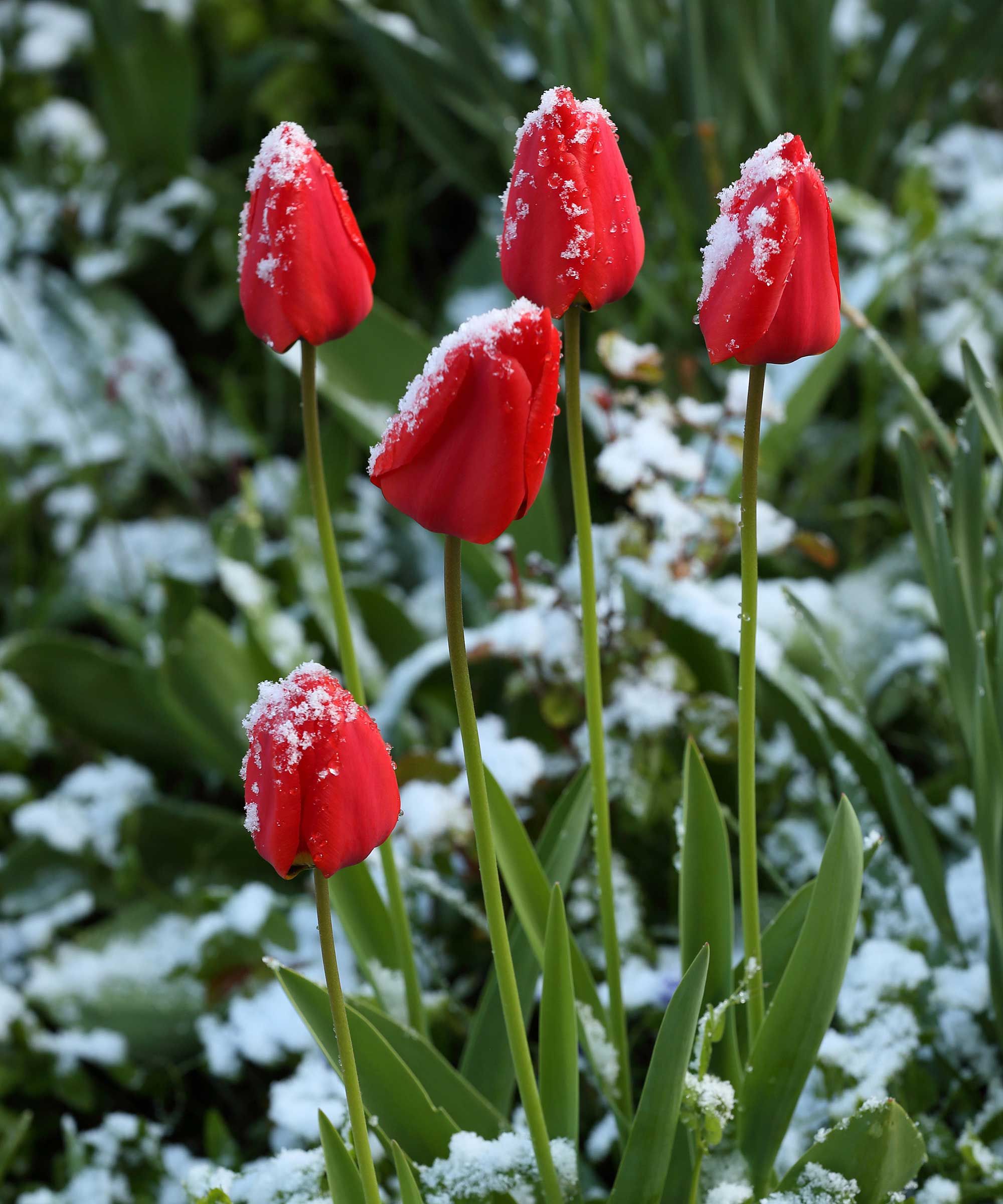How to protect tulips from frost – top tips to keep these spring favorites thriving
Don't let late-spring cold snaps defeat these flowering bulbs


Q: Back in the fall I planted lots of tulip bulbs in my flower beds and in two large containers on the patio. I am excited for them to bloom, but the weather has been very unpredictable recently and I'm worried that late frosts might spoil them once they're started growing. Will they need protection if temperatures suddenly drop?
A: Growing tulips for spring is an absolute must in my opinion – they bring so much color and spring joy to a garden. But sometimes, the foliage and flowers, having been coaxed out by warmer days, can suddenly be confronted by cold snaps.
The good news is that a few colder nights can generally be tolerated by these plants, and they'll even put up with a light frost, as long as it doesn't hang around for long. But if temperatures of 29˚F or below have been forecasted for an extended period of time, it's better to play it safe and provide some protection.

A former professional gardener and allotment-grower, Holly now spends her days writing about plants and outdoor living for Homes and Gardens, caring for her large collection of houseplants, and drawing her favorite blooms. Spotting spring flowers fills her with joy after the long winter months, and she particularly loves discovering new varieties of tulips to swoon over.

Long periods of cold temperatures can damage your tulips' foliage, buds, and blooms
How to protect tulips from frost – 3 simple ways
Don't let unexpected inclement weather spoil your spring flowers. Instead, protect your plants from frost with these three expert-approved methods.
1. Don't forget to mulch
Mulching when you plant your tulip bulbs in late fall will provide a valuable layer of protection against the worst of the winter weather. If you use an organic type of mulch, it will add nutrients to the soil as it decomposes, too.
It will help to keep soil temperatures relatively consistent, reducing the likelihood of it repeatedly freezing and thawing. As well as this, it will help to keep the ground moist.
2. Consider the location of your plants
If they're not too heavy, tulips planted in spring containers can be moved to a more sheltered area of your backyard, such as next to a sunny wall, when frosty temperatures loom.
Design expertise in your inbox – from inspiring decorating ideas and beautiful celebrity homes to practical gardening advice and shopping round-ups.
When planting your tulips into borders, choose a spot that gets plenty of sunshine and, again, has an element of protection if possible.
Bear in mind that cold air naturally flows downwards on sloping ground, creating a colder area – otherwise known as a 'frost pocket', explains the Royal Horticultural Society. Avoid planting your tulips in these.

Try to plant your tulips away from frost pockets and somewhere where they are protected from strong winds
3. Cover them up
If inclement weather is on the horizon, potentially putting your tulips in danger, consider covering them temporarily.
The bulb experts at Breck's suggest using hoop houses which can be made out of PVC pipe and plastic sheeting or horticultural fleece, or bought in garden centers or online (there are many kits available on Amazon). Try to ensure that the material is raised off of the plants.
Alternatively, Breck's also recommends using cloches. Again, these can be bought online – such as these Fshow reusable cloches from Amazon. Remove them when the temperatures rise again to prevent excess moisture buildup and to stop your plants from overheating.
'If the shop is already closed and you need protection now, then you can look for anything around the house that may work, like a plastic Rubbermaid bin or some cardboard boxes,' says Tina Ho, the Founder of Good Plant Care.
Jonathan Ames, the lead designer at online landscape design company Bacqyard, says you can also use a DIY cold frame: 'a simple structure made of wooden or metal frames covered with a transparent material, such as glass or plastic. Placing a cold frame around your tulips creates a protective barrier against frost and cold winds. Keep the top vented or remove it entirely during the day to prevent overheating.'
Wrap containers filled with tulips in bubble wrap or horticultural fleece to keep them warmer and reduce the risk of them cracking.
FAQs
Should you cut back frost-damaged foliage from your tulips?
As a general rule, you should always leave the foliage on your tulips to die right back and turn yellow, as it feeds the bulbs for more blooms the following year. So, even if it has been damaged by frost, keep those leaves on while they're still showing areas of green.
You can always transplant them to a flower bed that's out of the way if you want to clear space for other spring plants.
These tips aren't just for tulips – they can come in handy to protect other spring bulbs, too, including daffodils and hyacinths. So, keep an eye on the weather forecast and take action if needed, and your spring display will perform as prettily as you intended it to.

Holly started writing about gardening five years ago, and she is a regular contributor to Homes & Gardens. She has also written many gardening features for Woman & Home and Real Homes, too. She has previous experience as a professional gardener, where she helped to plant and maintain private gardens. Holly has also looked after allotment plots over the years and loves to grow her own flowers and veggies from seed. In her spare time, she enjoys visiting local gardens, botanical drawing, and tending to her ever-growing collection of houseplants.